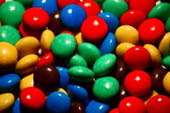
Purpose
To determine how probable it is that you will reach in a jar and pull out a certain color of M&M.
Additional information
It is important for people to know how probable something is – how likely is it that someone will win the lottery? How likely is it that someone will have an adverse reaction to a medication? Statistical trials can help people figure out how likely an outcome is.
Sponsored Links
Required materials
- 1 bag of M&M’s
- Several plastic cups
- Journal or logbook
- Calculator
Estimated Experiment Time
A few hours.
Step-By-Step Procedure
- 1. Open the bag of M&M’s and count how many there are total in the bag. Record this number in your journal. For exemplary purposes, let’s say that there are 100 in the bag.
- 2. Divide them into color groups and put each group in the plastic cups – yellow will go in one cup, red in another and so on.
- 3. Count how many of each color M&M there are and record this in your logbook or journal. Let’s say there are 25 yellow M&M’s and 50 blue ones.
- 4. What is the ratio of each color of M&M compared to the total number of M&M’s? In our example, there are 25 yellow M&M’s out of 100 total M&M’s. This means that for every four M&M’s, one of them is yellow. There are also 50 blue M&M’s out of 100 in our example, meaning that for every four M&M’s there are, two of them will be blue. You can reduce that by saying that for every two M&M’s in our example, one of them is blue.
- 5. Record all information and data in your logbook and use it to create a graph.
Note
Remember to do your calculations more than once to ensure complete accuracy!
Observation
In our example, the probability of selecting a blue M&M out of the bag of 100 M&M’s was one in two. There was also a one in four probability that you would choose a yellow M&M in the example. What are the probabilities of choosing each color in your bag of M&M’s?
Result
It is likely that it will be more probable for you to choose one color out of the bag of M&M’s than another. Which color are you most likely to choose? How can this experiment be applied to real life situations?
Sponsored Links
Take a moment to visit our table of Periodic Elements page where you can get an in-depth view of all the elements,
complete with the industry first side-by-side element comparisons!